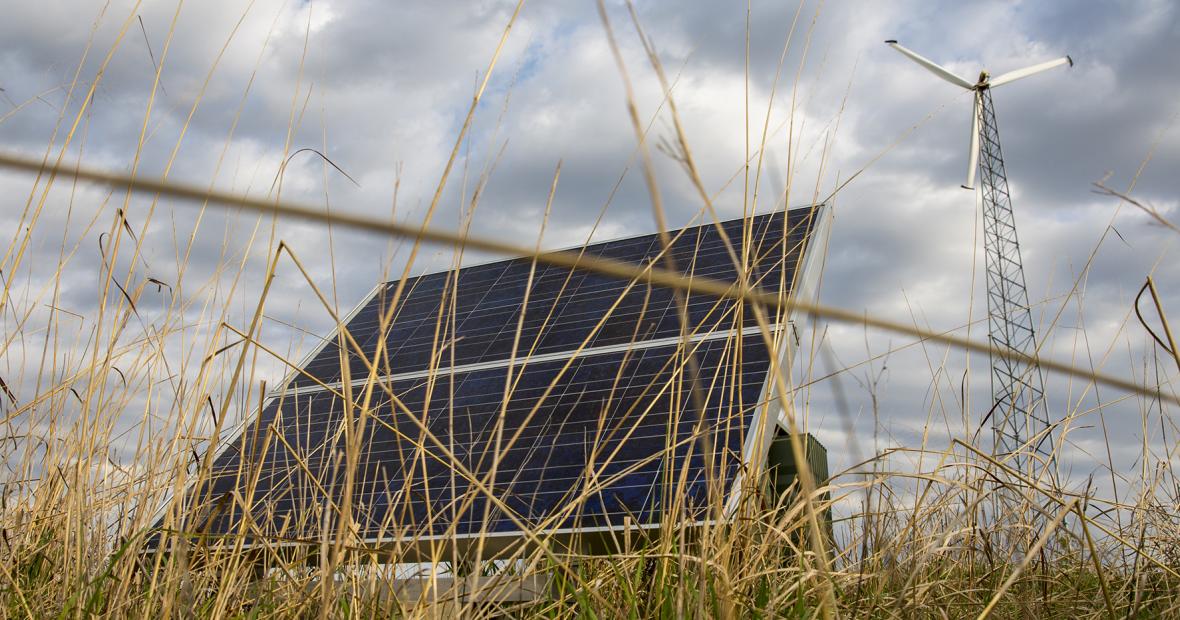A Greener Grinnell
For the past decade, Grinnell College has prioritized environmental sustainability, which is itself a social justice issue, in both constructing new buildings and maintaining century-old ones.
Building a Sustainable Campus
The Conard Environmental Research Area’s Environmental Education Center was the College’s first major sustainability effort. “It was a smaller building and gave us a chance to do everything right,” says Chris Bair ’96, environmental and safety manager. “Plus, if you can’t build an environmental education building sustainably, what can you do?”
The Environmental Education Center was the first LEED gold-certified building in Iowa and was the College’s first building with a wind turbine, water reclamation, and geothermal heating and cooling. Now the College’s preschool and pool buildings also use geothermal heating and cooling. The Noyce Science Center and the Bear Recreation and Athletic Center have cisterns that collect rainwater. Noyce’s provides water to the greenhouse and the Bear’s is used to water the football fields.
Facilities management is also working on a number of solar projects, including the recent installation of a 20-kilowatt solar unit on the facilities management building in addition to the solar hot water unit of Eco House. “And we’re exploring the possibility of putting 200 kilowatts worth of solar power on campus,” says Bair.
Global Research and Collaboration
Six students conducted research on sustainability in several German cities during spring break. They were accompanied by Bair and facilities manager Rick Whitney, as well as Lee Sharpe, associate professor of chemistry, and Liz Queathem, a biology lecturer. In this group Mentored Advanced Project, each student focused on a different aspect of sustainability with the intent to make recommendations to the College:
- Sophie Neems ’16 examined how change happens and what societal factors in Germany have caused increased sustainability efforts that just aren’t happening in the United States.
- Emma Leverich ’16 looked at the efficacy of a waste-to-energy process that uses biodigesters; the methane gas that the biodigesters produce would be siphoned off and burned for fuel.
- Zhi Chen ’17 investigated the potential implementation of solar energy on campus by surveying the available space and calculating the cost of installation.
- Ben Mothershead ’16 and Liza Morse ’15 compared the building certification programs and building codes of the United States and Germany. They spoke with several architects in both countries about their experience with sustainable design.
- Samantha Snodgrass ’16 researched storm water reclamation and infiltration.
When the students returned, they each wrote a paper on their research and presented the papers to the local city government, the Grinnell Area Chamber of Commerce, and the Iowa Economic Development Authority.
Importance of Visibility
One of the major lessons learned on the trip was the importance of making sustainable efforts more visible. If students are more aware of the resources they are consuming, they are likely to do more to curb their consumption.
Many of the College’s ongoing sustainability efforts are significant but may go unnoticed by students. Each summer facilities management updates a residence hall with LED lights, low-flow toilets, and efficient showerheads. They also connect each hall to the College’s central building automation and add set points to thermostats and window sensors that shut off the heat or air conditioners when windows are open.
In Germany, virtually every hotel in which the students, faculty, and staff stayed had a display in the lobby indicating how much energy had been produced by the building’s rooftop solar panels.
Starting this summer, facilities management will install submeters in residence halls to monitor water and electricity use. The hope is that once that information is on display, students will be more aware of their consumption. There has even been talk of starting conservation competitions between halls. “Renewable energy is out there and everyone is bragging about it,” says Bair. The group also took tours of green roofs and rainwater collection features.
“On Grinnell’s campus, you’re always aware of the social justice implications of pretty much everything,” says Bair. “I’d like sustainability to rise to that level.”
Sophie Neems ’16 is an anthropology and Spanish double major from Iowa City, Iowa.
Emma Leverich ’16 is a chemistry and anthropology double major from Clive, Iowa.
Zhi Chen ’17 is a computer science and history double major from Oakland, Calif.
Ben Mothershead ’16 is an economics major from Falls Church, Va.
Samantha Snodgrass ’16 is a biology major from Des Moines, Iowa.

